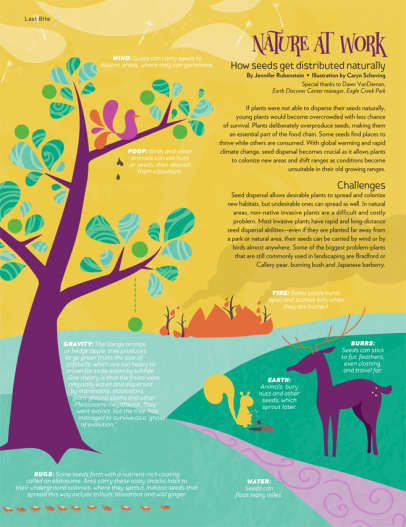Last Bite: Nature at Work
If plants were not able to disperse their seeds naturally, young plants would become overcrowded with less chance of survival. Plants deliberately overproduce seeds, making them an essential part of the food chain. Some seeds find places to thrive while others are consumed. With global warming and rapid climate change, seed dispersal becomes crucial as it allows plants to colonize new areas and shift ranges as conditions become unsuitable in their old growing ranges.
Challenges
Seed dispersal allows desirable plants to spread and colonize new habitats, but undesirable ones can spread as well. In natural areas, non-native invasive plants are a difficult and costly problem. Most invasive plants have rapid and long-distance seed dispersal abilities—even if they are planted far away from a park or natural area, their seeds can be carried by wind or by birds almost anywhere. Some of the biggest problem-plants that are still commonly used in landscaping are Bradford or Callery pear, burning bush and Japanese barberry.
WIND: Gusts can carry seeds to distant areas, where they can germinate
POOP: Birds and other animals can eat nuts or seeds, then deposit them elsewhere.
FIRE: Some seeds burst open and scatter only when they are burned.
BURRS: Seeds can stick to fur, feathers, even clothing, and travel far.
EARTH: Animals bury nuts and other seeds, which sprout later.
WATER: Seeds can float many miles.
GRAVITY: The Osage orange, or hedge apple, tree produces large green fruits the size of softballs, which are too heavy to travel far to be eaten by wildlife. One theory is that the fruits were originally eaten and dispersed by mammoths, mastodons, giant ground sloths and other Pleistocene megafauna. They went extinct, but the tree has managed to survive as a “ghost of evolution.”
BUGS: Some seeds form with a nutrient-rich coating called an eliaosome. Ants carry these tasty snacks back to their underground colonies, where they sprout. Indiana seeds that spread this way include trillium, bloodroot and wild ginger.
Special thanks to Dawn VanDeman, Earth Discover Center manager, Eagle Creek Park
Illustration by Caryn Scheving




